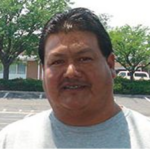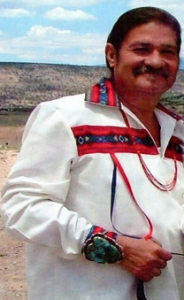The Navajo
The Navajo reservation includes approximately 27,000 square miles. Its boundaries extend from northwestern New Mexico into northeastern Arizona and southeastern Utah, a combined area larger than many U.S. states. Three smaller bands of Navajos are also located away from the main reservation boundaries at Alamo, To’hajiilee and Ramah. Key communities include Crownpoint, Shiprock, Alamo, To’hajiilee and Ramah. The capital of the Navajo Nation is Window Rock, AZ, located about 25 miles northwest of Gallup.
The Navajo people call themselves Diné, which in their own language, meaning “The People.” The Spanish, it is believed, started using the term Navajo when they entered the Southwest. They have endured much suffering in their past, including the infamous Long Walk in 1860, when the U.S. Army forcibly marched more than 8,000 Navajos to Bosque Redondo near Fort Sumner, where they were incarcerated for four years before being allowed to return to their homeland. The Navajos and the U.S. government signed the Treaty of 1868, creating the basis for relations still honored today.
Navajos are known for their handmade art: sand paintings, impressive silversmithing and dramatically patterned rugs and wall hangings as well as other traditional arts and crafts.
Acoma Pueblo
Acoma Pueblo (/ˈækəmə/) is a Native American pueblo approximately 60 miles (97 km) west of Albuquerque, New Mexico in the United States. Four communities make up the village of Acoma Pueblo: Sky City (Old Acoma), Acomita, Anzac, and McCartys. The Acoma Pueblo tribe is a federally recognized tribal entity. The historical land of Acoma Pueblo totaled roughly 5,000,000 acres (2,000,000 ha). The community retains only 10% of this land, making up the Acoma Indian Reservation. Acoma Pueblo is a National Historic Landmark.
According to the 2010 United States Census, 4,989 people identified as Acoma. The Acoma have continuously occupied the area for over 2000 years, making this one of the oldest continuously inhabited communities in the United States (along with Hopi pueblos). Acoma tribal traditions estimate that they have lived in the village for more than two thousand years.
Pueblo people are believed to have descended from the Anasazi, Mogollon, and other ancient peoples. These influences are seen in the architecture, farming style, and artistry of the Acoma. In the 13th century, the Anasazi abandoned their canyon homelands due to climate change and social upheaval. For upwards of two centuries, migrations occurred in the area. The Acoma Pueblo emerged by the thirteenth century. However, the Acoma themselves say the Sky City Pueblo was established in the 11th century, with brick buildings as early as 1144 on the Mesa indicating as such due to their unique lack of Adobe in their construction proving their antiquity. This early founding date makes Acoma Pueblo one of the earliest continuously inhabited communities in the United States.
The Pueblo is situated on a 365-foot (111 m) mesa, about 60 miles (97 km) west of Albuquerque, New Mexico. The isolation and location of the Pueblo has sheltered the community for more than 1,200 years. They sought to avoid conflict with the neighboring Navajo and Apache peoples.
Santo Domingo Pueblo
Santo Domingo is one of the largest Indian Pueblos in New Mexico. When Don Juan de Onate visited Santo Domingo in 1598, the Pueblo was on the north bank of Galisteo Creek, a few miles east of the present village. Galisteo floodwaters washed this village away shortly afterwards and the survivors established a new Pueblo near the Rio Grande, but flood waters struck Santo Domingo in 1692 and again in 1886, washing away much of the Pueblo each time. Most of the present Pueblo and the present mission church have been built since the disastrous flood of 1886. During much of the Spanish colonial period, Santo Domingo was an important Franciscan mission center and the ecclesiastical capital of New Mexico. A mission church erected here before 1607 by Fray Juan de Escalona, was considered one of the largest and finest in New Mexico. It was washed away in the 1886 flood, but most of the records and religious objects were saved.
Santo Domingo played host to many famous visitors during its long history, including Zebulon Pike in 1809 and Col. Stephen Watts Kearny in 1846.
In 1598, the Santo Domingo Tribe was designated as the Capitol of the 20 Pueblo Indian Tribes in the State of New Mexico. The inhabitants of Santo Domingo Pueblo today are conservative and traditional. Their ceremonial dances are considered among the finest to be seen in New Mexico.
The Laguna Pueblo
The Laguna Pueblo (Western Keres: Kawaika [kʰɑwɑjkʰɑ]) is a federally recognized tribe of Native American Pueblo people in west-central New Mexico, USA. The name, Laguna, is Spanish (meaning “small lake”) and derives from the lake located on their reservation. Originally, this body of water was the only lake in what is now the state of New Mexico, and was formed by an ancient dam that was constructed by the Laguna people.[citation needed] After the Pueblo Revolt of 1680-1696, the Mission San José de la Laguna was erected by the Spanish at the old pueblo (now Old Laguna), and finished around July 4, 1699.
The people of Laguna have a long history of residing in and farming along the Rio San José in west-central New Mexico. Laguna history begins long before the advent of written records in the Southwest. It is a common misconception that the Pueblo of Laguna began in 1699, at the time of the construction of the Mission. However, research of 1,449 archaeological sites and an anthropological analysis of the Laguna oral history have firmly proven that people have inhabited the area ranging from 6500 B.C. to the present.
The Acoma Pueblo and Pueblo of Laguna have many ties, including location, language and a shared high school.
The Pueblo of Laguna has a well-established Tribal Law system. The Pueblo of Laguna has participated as a “Weed and Seed” tribe. This Department of Justice program studied the enforcement of law and effectiveness of social programs on Native American lands.
The Irish surname Riley was adopted by many members of the Laguna tribe in the 1800s, for legal use in European-American culture, while they retained their Laguna names for tribal use.
 Andy Cadman – Navajo
Andy Cadman – Navajo
Andy Cadman is the older brother of Darrell Cadman and half-brother of Gary and Sunshine Reeves. Born in 1966 in Gallup, New Mexico, Andy began his career making beautiful stamped traditional jewelry at the age of 23. His work is highly prized for his use of gem grade natural turquoise set in sterling silver in distinctive world class designs.
Andy Cadman grew up in Gallup, New Mexico and attended Tohatchee High School. He currently has three children and enjoys being a full-time jeweler. Aside from his work, Andy has a passion for travel and golf.
 Greg Lewis
Greg Lewis
Greg Lewis is a silversmith who excels at creating fine American Indian jewelry in the traditional style. Greg is at least the 3rd generation of jewelers carrying on the time-honored traditions and techniques that have been handed down through his family. Greg Lewis began working with silver when he was just 15 by studying with his paternal grandfather, Alvin Concho Lewis of Acoma. So much influence comes from Greg’s grandfather including his Arrowhead hallmark, which Alvin first established in 1922.
Like his grandfather before him, almost everything that Greg Lewis does is by hand including most of his tools, which he creates out of old files and tool steel bar. All of his stamps are handmade too – either by Greg or passed down from his grandfather. Even the fine natural turquoise that Greg Lewis often sets in jewelry is hand-cut and hand-set. In fact, only Greg’s torch and buffing wheel are modern – a true testament to the level of workmanship in every unique piece that Greg Lewis makes.
Ben Yellowhorse
Ben comes from a family of nine children. Eight of the siblings have followed in the Yellowhorse Family long tradition of authentic handcrafted Navajo jewelry design. The ninth sibling has an accomplished career as a professional musician (Jaime Bird).
Ben Yellowhorse now lives on his Mother’s land in Laguna Pueblo, where he works his magic on sterling silver, turning it to breathtaking pieces of art. Ben started working on his craft at very young age, learning from his Father, Mother, brothers, uncles, aunts, and grandparents. He was taught how to work with a variety of metals and to never sacrifice quality by using cheaper or pre-manufactured materials. Ben’s jewelry is all hand stamped, each individual piece is a unique example of his talent and his family’s long tradition. His love for the Southwest is clearly seen in each magnificent piece of art that he creates.
Ben specializes with thick sterling sliver bracelets, but also works with other metals and other kinds of jewelry. By practicing his art, Ben is keeping his father’s memory and a Navajo tradition alive.

